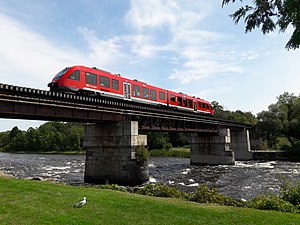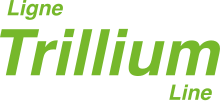Trillium Line
| Trillium Line | |||||||||||||||||||||||||||||||||||||||||||||||||||||||||||||||||||||||||||||
|---|---|---|---|---|---|---|---|---|---|---|---|---|---|---|---|---|---|---|---|---|---|---|---|---|---|---|---|---|---|---|---|---|---|---|---|---|---|---|---|---|---|---|---|---|---|---|---|---|---|---|---|---|---|---|---|---|---|---|---|---|---|---|---|---|---|---|---|---|---|---|---|---|---|---|---|---|---|
| Route length: | 8.0 km | ||||||||||||||||||||||||||||||||||||||||||||||||||||||||||||||||||||||||||||
| Gauge : | 1435 mm ( standard gauge ) | ||||||||||||||||||||||||||||||||||||||||||||||||||||||||||||||||||||||||||||
|
|||||||||||||||||||||||||||||||||||||||||||||||||||||||||||||||||||||||||||||
The Trillium Line ( French Ligne Trillium ) is a light rail line operated by diesel multiple units in the Canadian capital Ottawa . It is 8.0 km long, is operated by the transport company OC Transpo and is part of the O-Train system. Opened in 2001, the line runs north-south from Bayview to Greenboro.
Until September 2014, the north-south route was known as the O-Train. After construction began on the Confederation Line , which ran in a west-east direction , OC Transpo transferred the name to the entire future light rail network and renamed the first line the Trillium Line. Trillium refers to the large-flowered forest lily , the official symbol of the province of Ontario .
Pilot project
In the 1970s and 1980s, Ottawa decided against light rail and relied on Bus Rapid Transit with largely independent routes, on the assumption that high-quality bus operation would be more cost-effective than rail-bound means of transport. However, the originally estimated cost was exceeded by four and a half times ( $ 440 million instead of the budgeted $ 97 million). It was almost as expensive as the similarly long but far more powerful C-Train light rail in Calgary , which had an investment of $ 543 million in 2005. The Transitway in Ottawa finally reached its capacity limit (with 175 buses per hour in the central section) and there was no cost-effective way to increase the capacity further.
In the end, light rail systems proved to be the only way to significantly increase the capacity of local public transport. On October 15, 2001, the O-Train (as the Trillium Line was then called) opened as a pilot project . The costs of 21 million dollars were extremely low compared to full-fledged light rail new buildings, since an existing route of the Canadian Pacific Railway could be used (the subsections or "subdivisions" Ellwood and Prescott). Only the stations themselves and a turnout in the middle of the route had to be built. Due to the operation with diesel multiple units, no electrification of the line was necessary. In May 2011, around 12,000 passengers were counted every day, which was roughly twice the forecast.
From a legal point of view, the line is still a main line : after operations have closed, freight trains of the Ottawa Central Railway occasionally run on the southern part of the Trillium Line on their way to a site of the National Research Council .
Stations
- Bayview - provides a connection to the transitway and is the closest station to the city center. It is located just below the Wellington Street flyover and the transitway. Here you can change to the Confederation Line .
- Carling - Located between Carling Avenue and Preston Street. To the south of it follows a tunnel under Dow's Lake, an artificial lake on the Rideau Canal .
- Carleton - Located on Carleton University campus . To the south of the double-track station, the line crosses the Rideau River on a bridge.
- Mooney's Bay (formerly: Confederation ) - Located between Heron Road and Bronson Avenue, this station primarily opens up a federal government office complex and the nearby recreational area of the same name .
- Greenboro - Located on Bank Street near the South Keys Shopping Center . Offers another option to transfer to the transitway and to a large park-and-ride area.
The route is mostly single-track. Since 2001 there has been a turnout at Carleton station, there are two more south of Bayview and north of Greenboro (in the area of the future Walkley station).
vehicles
From 2001 three diesel-powered , low-floor multiple units of the type Bombardier Talent (class 643) with three cars each operated on the Trillium Line . The trains were originally procured by Deutsche Bahn and were later sold to OC Transpo. Both companies use a similar color scheme, so the red and white paintwork remained largely unchanged; the interior also essentially corresponded to a DB regional train.
In September 2011, Alstom announced that it would deliver six new Coradia LINT 41 two-part trains valued at $ 34 million. They were handed over to OC Transpo in June 2013 and replaced the Talent trains on March 2, 2015. The color scheme stayed the same.
Failed expansion project
In July 2006, Ottawa City Council approved a project to expand the north-south route. New sections were planned from Greenboro south to Barrhaven and from Bayview east to the University of Ottawa . The existing line should also have been expanded to two tracks. If the route through the city center had been flush with the street, the O-train would have become a tram-train line. A consortium led by Siemens was awarded the contract to carry out the project . However, before the mayoral elections, the $ 778 million project came under increasing attack. Finally, in December 2006, it was canceled. Three years later, the city reached an agreement with the consortium to pay $ 36.7 million in damages .
Current development
From 2001, the trains initially ran every 15 minutes. After the construction of two new turnouts, the installation of a new signaling and train protection system and the purchase of new trains from Alstom, the cycle was reduced to ten minutes on March 2, 2015. The aim is to run every 8 minutes. The cost of the expansion was $ 60.3 million. From May to September 2013, operations on the Trillium Line were suspended in order to be able to carry out the necessary work.
The traffic master plan of the city of Ottawa from November 2013 includes the extension of the Trillium Line by a further 8 km. On the Canadian Pacific Railway route, the line is to run from Greenboro in a southerly direction to Bowesville station in the Riverside South district . Intermediate stations are planned in South Keys and Leitrim (each with a new turnout). Two new intermediate stations, Gladstone and Walkley, are to be built on the existing part of the Trillium Line.
The City of Ottawa is also planning to build a 3 km branch route from South Keys to Macdonald-Cartier International Airport . If this section were to be built, the airport station would be between the terminal and the parking garage. The cost of this project is estimated at $ 100 million and is half covered by the Province of Ontario. Another idea is to extend the Trillium Line north to Gatineau in the province of Québec ; this could reactivate a currently unused bridge over the Ottawa River , the Prince of Wales Bridge.
Web links
- OC Transpo - Trillium Line
- Project website 2nd stage (English, French)
Individual evidence
- ↑ O-Train name approved for Ottawa light rail system. CBC News , September 17, 2014, accessed on August 12, 2015 (English).
- ↑ Harry W. Gow: Ottawa's BRT "Transitway": Modern Miracle or Mega-Mirage? Light rail now, May 18, 2001, accessed on August 12, 2015 .
- ^ Calgary's CTrain - Effective Capital Utilization. (PDF, 1.3 MB) Calgary Transit, December 1, 2005, p. 8 , accessed on August 12, 2015 .
- ↑ Downtown can't take more buses. (No longer available online.) Ottawa Citizen, Nov. 27, 2007, archived from the original on Sept. 24, 2015 ; accessed on August 12, 2015 . Info: The archive link was inserted automatically and has not yet been checked. Please check the original and archive link according to the instructions and then remove this notice.
- ↑ Map of the rail network around Ottawa. niagararails.com, accessed August 12, 2015 .
- ^ Ottawa O-Train extension proposed. Railway Gazette International, May 24, 2011, accessed August 12, 2015 .
- ^ Ottawa's O-Train (Part I): a Little German Train in Canada. Catbus, March 29, 2013, accessed August 12, 2015 .
- ^ OC Transpo chooses Alstom to supply six new commuter trains to Ottawa. Alstom, January 31, 2012, accessed August 12, 2015 .
- ^ In Ottawa, Alstom introduces first European-style commuter trains for North America. Alstom, June 25, 2013, accessed August 12, 2015 .
- ↑ New Trains improve O-Train Trillium Line service. City of Ottawa, March 2, 2015, accessed August 12, 2015 .
- ^ Ottawa's O-Train back on track. CTV , September 3, 2015, accessed August 12, 2015 .
- ^ Transportation Master Plan. City of Ottawa, 2013, accessed August 12, 2015 .
- ↑ a b Trillium Line South. In: Stage 2 Light Rail Transit. City of Ottawa, 2015, accessed August 12, 2015 .
- ^ Changing trains likely for proposed O-Train airport link. Ottawa Citizen, January 14, 2015, accessed August 12, 2015 .
- ↑ David Reevely: Wynne promises to pay $ 158M for extra-east and south LRT extensions. Ottawa Citizen , June 3, 2016, accessed June 4, 2016 .



